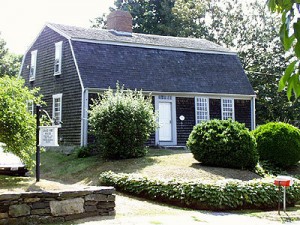History
The following is from Wikipedia:
Tiverton was incorporated by English colonists in 1694 as part of the Province of Massachusetts Bay. In 1746, in the final settlement of a long colonial boundary dispute between Rhode Island and Massachusetts, Tiverton was annexed to Rhode Island by Royal Decree (together with its fellow towns along the eastern shore of Narragansett Bay, Barrington, Bristol and Little Compton, and the town of Cumberland, to the north of Providence). Tiverton was incorporated as a town of Rhode Island in 1747. Until that year, Tiverton also controlled the area of East Freetown, Massachusetts, as an outpost. The boundary settlement of 1746 had put East Freetown in Massachusetts, and in 1747 it was purchased by Freetown.
Men from the Tiverton outpost took part in the Battle of Freetown, on May 25, 1778, during the Revolutionary War. For about three years of that war, December 1776 to October 1779, Rhode Island proper (now known as Aquidneck Island) was occupied by the British. During this time, Tiverton was a refuge for Americans fleeing this occupation, and a mustering place for colonial forces, gathering to drive away the British. (The occupying forces eventually were withdrawn strategically, as General Clinton marshalled his forces for the 1780 British invasion of South Carolina.)
In its early days, Tiverton was chiefly a farming community with some fishing and boat construction. Until 1900 the manufacture of menhaden oil, a fish derivative, was one of the primary industrial pursuits. Cotton and woolen mills were established as early as 1811, when Colonel Joseph Durfee established a spinning mill at Cook Pond, in what it now the city of Fall River, Massachusetts.
In 1856, the northern part of the town was set apart from Tiverton, and renamed Fall River, Rhode Island, by the Rhode Island General Assembly. On March 1, 1862, in a case between the states that reached the United States Supreme Court, both Fall Rivers were made part of Massachusetts and the state boundary was placed in its current location near State Avenue.
Mark's Stadium is a former soccer stadium located in North Tiverton, Rhode Island. During the 1920s and early 1930s, it was the home of Fall River Marksmen, one of the era's most successful soccer teams. It is one of the earliest examples of a soccer-specific stadium in the United States. After the demise of the Marksmen, the stadium was used as a home ground by other local teams, most notably Fall River F.C. and Ponta Delgada S.C..
Tiverton's First Settlers; The Wampanoags - Courtesy of Barbara Pelletier
Points of Interest
 CHACE-CORY HOUSE. (1730) 3908 Main Road at Tiverton Four Corners. Historic District. This gambrel-roofed building is now owned by the Tiverton Historical Society. Special exhibits throughout the season. OPEN: May thru September on Sundays from 2:00-4:30 p.m., and by appt. 624-4013, 624-8881.
CHACE-CORY HOUSE. (1730) 3908 Main Road at Tiverton Four Corners. Historic District. This gambrel-roofed building is now owned by the Tiverton Historical Society. Special exhibits throughout the season. OPEN: May thru September on Sundays from 2:00-4:30 p.m., and by appt. 624-4013, 624-8881.
FORT BARTON. Highland Road. Original redoubt built during the American Revolution. It was the troop staging area for the invasion of Aquidneck Island and Newport and the eventual Battle of Rhode Island. Observation tower and 3 miles of trail walks. OPEN: Year-round, sunrise to sunset. Newport News article about Fort Barton and new sign.
RUECKER WILDLIFE REFUGE. Seapowet Avenue. Audubon Society of Rhode Island sanctuary. 48 acres, with 1.5-mile trails winding through woodland, meadow, salt marsh, and open water. Feeding herons, egrets, and osprey. Variety of plant life. Gift of Miss Emilie Ruecker. OPEN: Daily, dawn to dark. 949-5454.

Tiverton's Timber Rattlesnakes - Fact and Fiction article
Also see the Tiverton Historical Society FaceBook Page HERE


